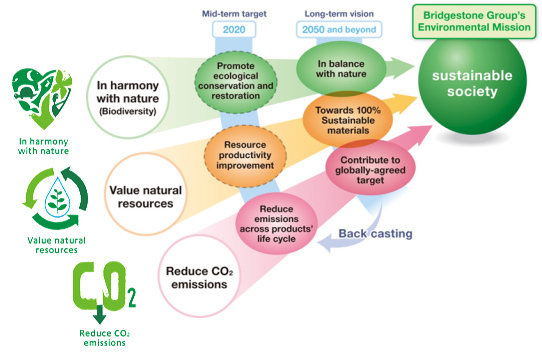About Bridgestone Corporation:
Bridgestone Corporation, headquartered in Tokyo, is the world’s largest tire and rubber company. In addition to tires for use in a wide variety of applications, it also manufactures a broad range of diversified products, which include industrial rubber and chemical products and sporting goods. Its products are sold in over 150 nations and territories around the world.
News - 2013
Targeting Future Practical Viability by Bolstering Functionality
2013/11/21
Tokyo (Nov. 21, 2013) - Bridgestone Corporation revealed today its second generation "Air Free Concept (Non-Pneumatic) Tire" at the 43 Tokyo Motor Show 2013. The revolutionary new design features improved load-bearing capabilities, environmental design and driving performance. The latest improvements to the "Air Free Concept Tire" brings Bridgestone one step closer to a viable, commercially available air free tire.
Special Features of "Air Free Concept Tire"
With a unique structure of spokes stretching along the inner sides of the tires supporting the weight of the vehicle, there is no need to periodically refill the tires with air, meaning that the tires require less maintenance. At the same time the worry of punctures is eliminated. In addition, the spoke structure is made from thermoplastic resin*1 and, along with the rubber in the tread portion, the materials used in the tires are recyclable, contributing to the efficient use of resources. Further, by pursuing extremely low rolling resistance and contributing to reductions in CO2 emissions through use of proprietary technologies, Bridgestone believes it is possible to achieve even higher levels of environmental friendliness and safety. Bridgestone is pursuing this technological development with the aim of achieving a "cradle to cradle" process that proactively maximizes the cyclical use of resources from worn tires into new tires and the use of recyclable resources.



New technologies used in and special features of the second generation tires are as follows.
1.Increased Versatility Through Improved Load-Bearing Capabilities and Driving Performance Bridgestone is further optimizing the spoke structure by using high-strength but flexible high-performance resin as a material and employing finite element method (FEM) simulations in the design to reduce stress and deformation in the inner part of the tire. By doing so, the second generation of "Air Free Concept tire" has increased versatility through improved load-bearing capabilities and driving performance compared with the first generation *2. High-speed travel (maximum 60 km/h) in ultralight vehicles*3 has also become possible.
2.Pursuing Low Rolling Resistance to Reduce CO2 Emissions About 90% of energy loss from tire rolling resistance comes from repeated changes in the shape of tires as they roll. In the second generation of airless tires, Bridgestone has succeeded in making a significant reduction in energy loss by using proprietary materials technologies and simplifying the structure of the tires. As a result, these "Air Free Concept tire" have achieved the same level of low rolling resistance as our pneumatic fuel-efficient tires, making possible a contribution to reductions in CO2 emissions.
The Bridgestone Group's Environmental Mission Statement outlines its goal to help contribute to a more sustainable society, with particular emphasis on three areas: ecological conservation, resource conservation, and reduction of CO2 emissions. The statement clarifies the direction of the Group's long-term environmental aspirations as it pushes forward with a variety of activities that contribute to environmental preservation. Bridgestone is advancing development of the "Air Free Concept tire" as a more environmentally friendly product than existing tires and aims to bring about commercial use in a wide range of vehicles as soon as possible.
Bridgestone believes that through effective resource usage and efficient operations alongside reduced CO2 emissions from improved fuel efficiency, as part of its aim to achieve a balance between its business and the environment, it can continue to offer attractive products to its customers far into the future. The Company will continue to implement multiple technological innovations to help bring about a more sustainable society.
The "Air Free Concept tire" will be displayed at Bridgestone's booth at the 43rd Tokyo Motor Show 2013, which opens on Wednesday, November 20*4.
- A synthetic resin that becomes flexible when heated, can be processed into a variety of shapes, and becomes hard when cooled.
- The changes from heating and cooling can generally be repeated, making it easy to both mold and recycle the material.
- Conditions for the first generation airless concept tire test vehicle: Vehicle weight of 100kg and maximum speed of 6 km/h Conditions for the second generation airless concept tire test vehicle: Vehicle weight of 410kg and maximum speed of 60 km/h
- Vehicles for one or two people which are more compact than automobiles, have a small turning circle, are highly environmentally friendly, and allow easy local movement.
- Nov. 20 and 21 are press days and Nov. 22 is a special guest day. The event is open to the general public from Nov. 23 to Dec. 1.
(Note) The airless concept tire is one of Bridgestone's initiatives aimed toward 100% use of sustainable materials and contributing to globally agreed CO2 emissions reduction targets (reduction of at least 50%) as part of the Company's long-term vision.

